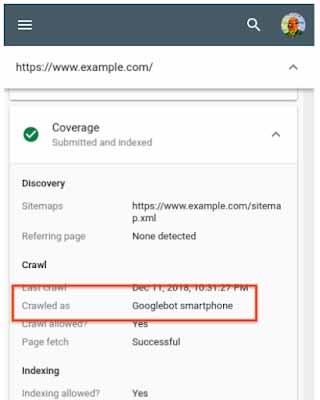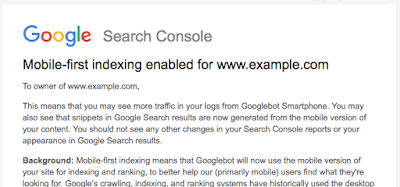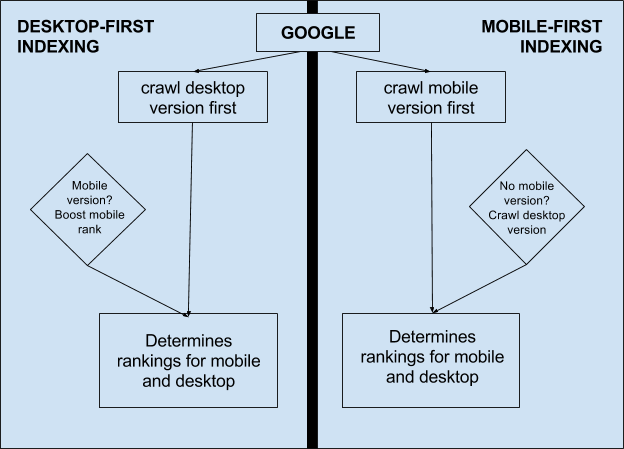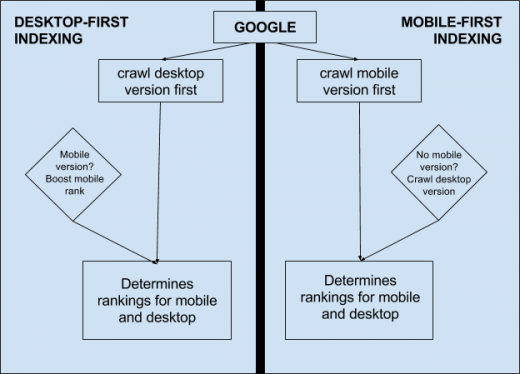Google’s Mobile-First Indexing: What You Need to Know in 2019
Mobile-first indexing makes Googlebot show the mobile version of pages in its SERPs by default. Previously, Google’s crawling, indexing, and ranking systems used the desktop version of a website’s content and this can cause ranking problems for mobile users when there’s a significant difference between the desktop and mobile versions of the same page.
Google started rolling out mobile-first indexing in March 2018 but the search engine isn’t finished yet. This article tells you everything you need to know about mobile-first indexing and what to do if your site hasn’t been changed over.
Has our site been moved over to mobile-first indexing?
If your site has already been moved over to mobile-first indexing, you will have received an email from Google, entitled “Mobile-first indexing enabled for [domain]” for each website.
Can confirm.
Also for unimportant sites that aren’t particularly optimized for mobile or anything. pic.twitter.com/U6hUKjw93A
— Pascal Landau (@PascalLandau) April 30, 2018
If you haven’t seen this email yet, you can check whether your site has been moved over by using the URL Inspection Tool in Search Console. You can check any URL on your website to see how it was last crawled and indexed by Google.

Note: You’ll only see a difference in the URL Inspection Tool if you have separate mobile versions of the same page. Responsive sites aren’t affected and mobile-first indexing will have no significant impact.
If your website still hasn’t been moved over to mobile-first indexing yet, then it’s probably only a matter of time. When the switch is made, you should get the notification email mentioned above, as well as a notification in Search Console for each domain affected.

After this, you’ll see a significant increase in crawl rate from Google’s mobile bot and the mobile version of your pages will start showing in search results (if you have separate mobile pages). For responsive and desktop-only websites, nothing should change, aside from the increased crawl rate, but it’s a good idea to run an audit after you get this notification to make sure nothing out of the ordinary is going on.
Starting from 1 July 2019, mobile-first indexing is the default for all new domains, which means any websites created since then will already be indexed on a mobile-first basis.
Is there any way to speed things up?
Google is taking its time with mobile-first indexing because it wants to make sure the migration has little or no negative impact on websites that deliver positive mobile experiences. This is a change that affects every page Google indexes and it needs to be as undisruptive as possible.
If your site hasn’t been moved over yet, this doesn’t mean there’s necessarily anything wrong. However, last year, Google explicitly said it started by migrating sites “that follow the best practices for mobile-first indexing”. Since then, regarding sites that haven’t been switched over yet, it has said: “We’ll continue monitoring and evaluating pages for their readiness for mobile-first indexing”
So, if your website hasn’t been moved over to mobile-first indexing yet, it’s worth making sure you’ve followed the best practices defined by Google.
How to prepare for mobile-first indexing
Google has released instructions on how to prepare for mobile-first indexing and having any issues here could get in the way of the switch.
If you serve separate mobile and desktop pages or use dynamic content delivery for different device types, make sure you have the following covered before mobile-first indexing rolls out.
- Your mobile and desktop pages contain the same content
- Both versions of your page have the necessary structured data
- Both versions of your page have the necessary metadata
- Both versions of your page are verified in Search Console
- Any rel=hreflang tags for internationalisation include separate links for mobile and desktop URLs
- Your servers can handle any increase in crawl rate for the mobile version of your site
- Your robot.txt directives are the same (and optimised) for both desktop and mobile versions
- Correct use of rel=canonical and rel=alternate link elements between mobile and desktop versions
Once again, all of these points are part of the usual mobile optimisation best practices and none of this should be new to you. There’s nothing wrong with having separate mobile and desktop sites, as long as they’re optimised correctly, and – let’s be honest – there are plenty of responsive websites that are poorly optimised for mobile.
If it’s going to take a lot of work for you to get your pages ready for mobile-first indexing, then it could be worth making the jump to a responsive design while you’re at it. However, a well-optimised experience shared across mobile and desktop pages is always going to be better than a poorly optimised responsive experience – so don’t lose sight of the end result for the sake of a more popular process.
Mobile-first indexing FAQ
Now that you know how to check the mobile-first status of your website and how to prepare for the switch, let’s address some of the most common questions we receive about mobile first-indexing.
What is mobile-first indexing?
Before we give our explanation of mobile-first indexing, let’s look at the description Google offered up when it announced the rollout:
“To recap, our crawling, indexing and ranking systems have typically used the desktop version of a page’s content, which may cause issues for mobile searchers when that version is vastly different from the mobile version. Mobile-first indexing means that we’ll use the mobile version of the page for indexing and ranking, to better help our – primarily mobile – users find what they’re looking for.” – Webmaster Central Blog
That’s about the best, short description of mobile-first indexing we’ve seen over the past few years. Essentially, it all comes down to the fact that the majority of Google searches are made on mobile but the results are still formulated by a system that ranks desktop pages first. The problem is, mobile pages often differ from their desktop alternatives and it makes little sense to send people to pages optimised for desktop when they’re using mobile.
Mobile-first indexing shifts the priority to the mobile version of pages to create better results and experiences for Google’s predominantly mobile users.
This doesn’t mean Google is going mobile-only or creating a separate index for mobile and desktop results. It simply means mobile pages will be crawled first and Google will fall back to desktop if no mobile version is found.
What does mobile-first indexing mean for SEO?
Although mobile-indexing sounds like a huge deal that’s going to change the way Google Search operates, the impact on most SEOs and website owners will be minimal. We’re certainly not looking at another mobilegeddon and there’s no need to panic as mobile-first indexing rolls out.
However, it’s important to know whether you will be affected or not, by how much and what you need to do about it.
How will this affect my search ranking?
This depends entirely on how your website and pages are optimised for mobile. Firstly, if your website is designed responsively – in other words, your mobile and desktop pages are one and the same – then you shouldn’t be affected by mobile-first indexing. In these cases, your mobile and desktop pages are the same and simply adapt to accommodate different screen sizes, which is the design approach Google recommends for mobile optimisation.
The websites that’ll be most affected by mobile-first indexing are those that provide separate mobile and desktop pages for users, depending on which device they’re using. In this scenario, the mobile version will now be crawled first and this could impact your search ranking for a number of reasons:
– You serve different content on the mobile and desktop versions of a page
– Your mobile pages lack structured data
– Your mobile pages lack metadata
– The mobile version of a page isn’t correctly verified in Search Console
– The link profiles pointing toward your mobile pages are weaker than the desktop versions
– Your mobile pages are poorly optimised for mobile
Most of the potential problems here come down to poor mobile optimisation so follow the usual best practices and you should be fine. However, there are a couple of technical SEO issues that could cause serious problems if you don’t know what to look out for.
First of all, make sure the mobile and desktop versions of each page are both verified in Search Console. Secondly, the link profile for your mobile pages will be different from their desktop versions, for better or worse. Which means you could see a change in ranking based on the quality of link profiles your mobile pages currently have.
You can find out more best practices for mobile-first indexing at Google Developers and the same page also gives details on how various types of pages might be affected. Here’s a quick summary of the impact mobile-first indexing should have on different websites:
Desktop only
Your site is desktop only and doesn’t have a mobile-friendly version.
No change. The mobile version is the same as the desktop version.
Responsive web design
Your site adjusts for screen size.
No change. The mobile version is the same as the desktop version.
Canonical AMP
All your web pages are created in AMP HTML.
No change. The mobile version is the same as the desktop version.
Separate URLs
Each desktop URL has an equivalent different URL that serves mobile-optimised content. This site type is also known as an m-dot site.
Google prefers the mobile URL for indexing. To prepare for mobile-first indexing, follow our best practices.
Dynamic serving
Your site serves different content based on the user’s device. Users only see one URL.
Google prefers the mobile optimised content for indexing. To prepare for mobile-first indexing, follow our best practices.
AMP and non-AMP
Your site has both AMP and non-AMP versions of a page. Users see two different URLs.
Google prefers the mobile version of the non-AMP URL for indexing. If your non-AMP mobile version uses dynamic serving or separate URLs, follow our best practices.
How does mobile-first indexing work?
Back in January, Bridget Randolph gave her answer to this question in an article for the Moz blog. Here’s what she had to say:
“It’s called ‘mobile-first’ because it’s not a mobile-only index: for instance, if a site doesn’t have a mobile-friendly version, the desktop site can still be included in the index. But the lack of a mobile-friendly experience could impact negatively on the rankings of that site, and a site with a better mobile experience would potentially receive a rankings boost even for searchers on a desktop.”
To help illustrate how this works, Bridget included the following visualisation in her article:
Source: Moz blog, Bridget Randolph
As the graphic shows, mobile-first indexing changes the default behaviour of Google for each search so that it crawls the mobile version of your page when there’s one available. When there isn’t a separate mobile version, Google reverts to indexing your desktop page and determines its ranking as normal.

What does “mobile-first indexing enabled” mean for your site?
When your website has been moved over to mobile-first indexing, you’ll receive an email from Google and a notification in Search Console, telling you that mobile-first indexing has been enabled on your domain.
This means Google has tested its crawling, indexing, and ranking systems on the mobile version of your pages and is happy with the results. The testing is now done and Google has enabled these systems to do their thing, meaning your site has been switched over to mobile-first indexing.
Summing up
The main takeaway from our look at mobile-first indexing today is there’s nothing to panic about. If you happen to run separate mobile and desktop pages, you still shouldn’t experience any major issues unless your mobile optimisation strategy is in need of an update. Either way, it’s a good idea to run the necessary checks before mobile-first indexing is enabled for your site, even if you expect nothing to change after the switch.
Digital & Social Articles on Business 2 Community
(23)


